[TCM Diagnosis] Chapter 1: Eight Principles Differentiation
Section 4: Yin-Yang Differentiation – Lecture 8

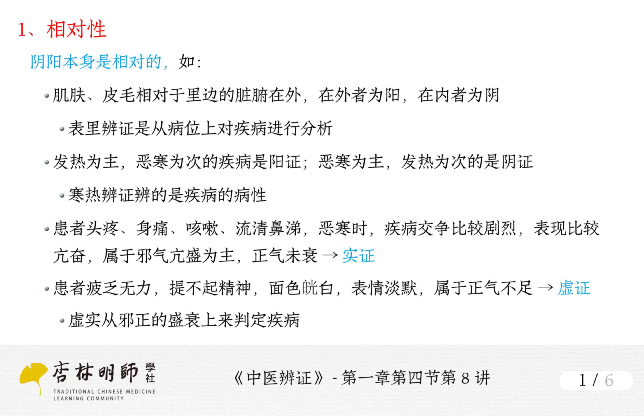
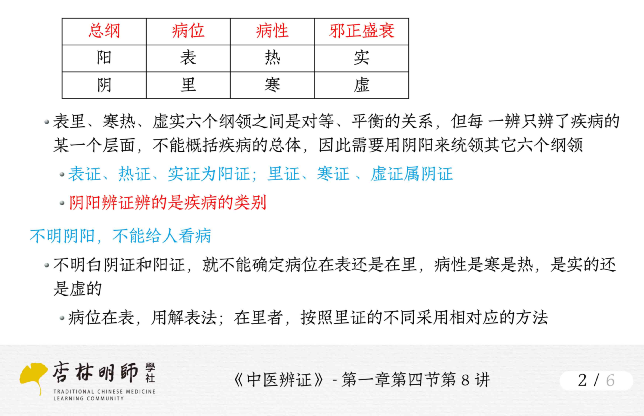
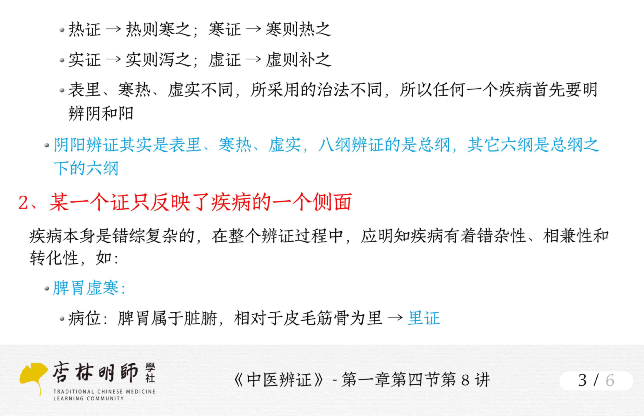
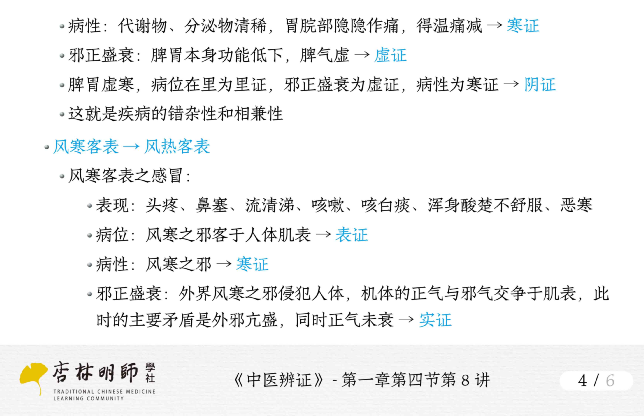
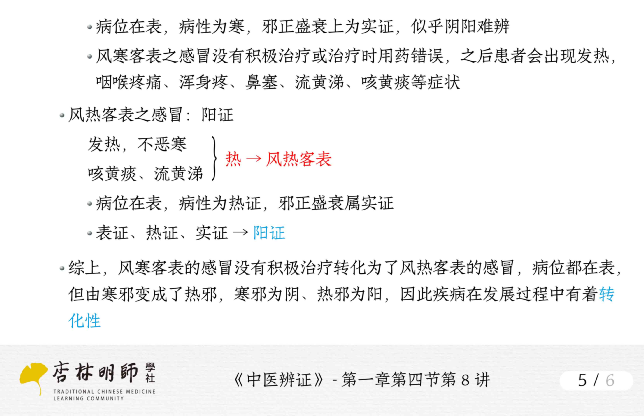
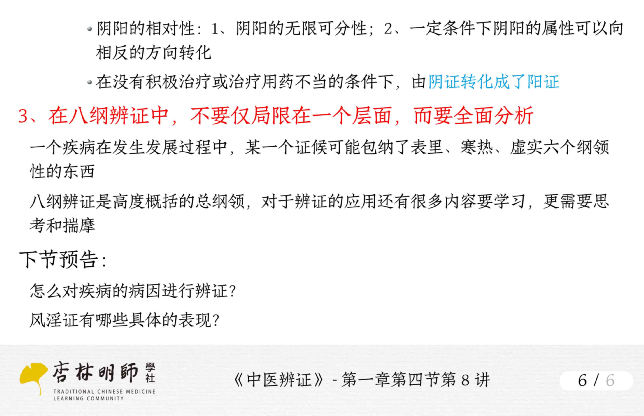
Question: What is Yin-Yang Differentiation?
Answer: Yin-Yang Differentiation is a framework for identifying types of syndromes, serving as the general principle of the Eight Principles Differentiation. Based on the characteristics of disease symptoms and signs, diseases can be classified into Yin syndromes and Yang syndromes, which helps to outline the diagnosis.
It is generally believed that when the disease is located on the surface and characterized by heat, it is a Yang syndrome. Conversely, when the disease is located internally and characterized by heat with deficiency of righteous Qi, it is a Yin syndrome.
Question: How to understand the relativity of Yin and Yang?
Answer: The relativity of Yin and Yang refers to the fact that the Yin and Yang attributes of phenomena or the opposing sides within a phenomenon are not absolute or unchanging, but rather relative. This is mainly expressed in three aspects:
1. Infinite divisibility. This means that the Yin and Yang aspects of phenomena can be infinitely divided as the levels of classification change. For example, day and night can be divided into Yin and Yang, with daytime being Yang and nighttime being Yin; daytime can further be divided into morning (Yang) and afternoon (Yin), while nighttime can be divided into the first half (Yin) and the second half (Yang). This infinite divisibility illustrates that Yin can be further divided into Yin and Yang, and Yang can also be divided into Yin and Yang.
2. The premise and basis for dividing Yin and Yang can change, leading to a change in the Yin and Yang attributes of phenomena. For instance, when considering the organs, the Lung (Fei) is in the upper jiao and is Yang, while the Liver (Gan) is in the lower jiao and is Yin. However, if we classify based on the movement of Qi, the Lung Qi, which governs descent, is Yin, while the Liver Qi, which governs ascent, is Yang.
3. The Yin and Yang attributes of phenomena can transform into their opposites under certain conditions. When a phenomenon develops to a certain stage or under certain conditions, what was originally dominated by Yang may transform into a state dominated by Yin, and vice versa. This indicates that the overall attributes of phenomena can change. This is referred to as “heavy Yin must lead to Yang,” “heavy Yang must lead to Yin,” “extreme cold generates heat,” and “extreme heat generates cold.”
Question: What is the relationship between the eight principles in Eight Principles Differentiation?
Answer: The relationships between exterior and interior syndromes, cold and heat syndromes, and deficiency and excess syndromes reflect several contradictory yet unified phenomena during the disease process. These three pairs of syndromes summarize the disease from different perspectives, indicating only certain characteristics of the disease without reflecting its entirety. These six syndromes are in a parallel relationship; although there is some connection between them, they cannot encompass or replace each other.
Yin and Yang can summarize the disease from a higher level, indicating that, relatively speaking, exterior syndromes, heat syndromes, and excess syndromes belong to Yang, while interior syndromes, cold syndromes, and deficiency syndromes belong to Yin. The two principles of Yin and Yang can govern the other six principles, thus becoming the overarching principle of the Eight Principles.
Question: How to understand the compatibility of the eight principle syndrome types?
Answer: Eight Principles Differentiation is a framework for differentiation, but in actual clinical practice, differentiation often involves the overlap of related syndromes. According to the concept of syndrome compatibility, any three principles, excluding the opposing pairs (exterior and interior, cold and heat, deficiency and excess), can form a compatible syndrome.
Through various combinations, eight types of syndromes can be formed: exterior excess cold syndrome, exterior excess heat syndrome, exterior deficiency cold syndrome, exterior deficiency heat syndrome, interior excess cold syndrome, interior excess heat syndrome, interior deficiency cold syndrome, and interior deficiency heat syndrome.
However, in clinical practice, true exterior deficiency cold syndrome and exterior deficiency heat syndrome are rarely seen. For example, the commonly seen Spleen and Stomach deficiency cold syndrome is, from the perspective of Eight Principles Differentiation, an interior syndrome, deficiency syndrome, and cold syndrome combined, belonging to a Yin syndrome.
Question: How to understand the transformability of Eight Principles Differentiation?
Answer: In the process of disease development and change, the opposing syndromes within the Eight Principles can interchange and transform into each other under certain conditions.
There are two possible outcomes after syndrome transformation: one is that the condition worsens, progressing from mild to severe; the other is that the condition improves, progressing from severe to mild, leading towards recovery.
The transformations of Eight Principles syndromes include the entry and exit of exterior and interior, the transformation of cold and heat, and the transformation of deficiency and excess. For instance, if an exterior pathogen has not been resolved, it may enter the interior and transform into heat; if an exterior cold pathogen is not dispersed in time, it may enter the interior and transform into heat; if a condition persists, the righteous Qi may gradually be depleted, leading to a transformation from excess syndrome to deficiency syndrome.
Question: What is upper heat and lower cold? What is upper cold and lower heat?
Answer: Upper heat and lower cold refer to a condition where the patient simultaneously experiences heat in the upper jiao and deficiency cold in the Spleen and Stomach, presenting symptoms such as chest heat, sore throat, dry mouth, and frequent nausea, along with abdominal pain relieved by warmth and loose stools.
Upper cold and lower heat refer to a condition where the patient has Spleen and Stomach deficiency cold and bladder damp-heat, presenting symptoms such as cold pain in the stomach, vomiting clear fluids, along with frequent urination, painful urination, and short yellow urine.
Question: What is exterior cold and interior heat? What is exterior heat and interior cold?
Answer: Exterior cold and interior heat refer to a condition where the exterior cold has not been resolved, leading to internal heat, or where there is pre-existing internal heat that is further affected by wind-cold, presenting symptoms such as chills, fever, no sweating, headache, body aches, preference for drinking, irritability, constipation, and yellow tongue coating.
Exterior heat and interior cold refer to a condition where the body has insufficient Yang Qi and is further affected by wind-heat, presenting symptoms such as fever, chills, sweating, headache, sore throat, and clear urination.
Question: Why is it said that those who do not understand Yin and Yang cannot treat diseases effectively?
Answer: Yin-Yang Differentiation is a framework for identifying types of syndromes, serving as the general principle of the Eight Principles Differentiation. Based on the characteristics of disease symptoms and signs, diseases can be classified into Yin syndromes and Yang syndromes, which helps to outline the diagnosis.
The relationships among exterior and interior, cold and heat, deficiency and excess are parallel; although there is some connection between them, they cannot encompass or replace each other. However, Yin and Yang can summarize the disease from a higher level, indicating that, relatively speaking, exterior syndromes, heat syndromes, and excess syndromes belong to Yang, while interior syndromes, cold syndromes, and deficiency syndromes belong to Yin. The two principles of Yin and Yang can govern the other six principles, thus becoming the overarching principle of the Eight Principles.
Not understanding Yin and Yang essentially means not distinguishing between exterior and interior, cold and heat, deficiency and excess, which makes it impossible to appropriately apply methods such as resolving the exterior, addressing the interior, dispersing cold, dispersing heat, tonifying deficiency, and draining excess. Therefore, it is said that those who do not understand Yin and Yang cannot effectively treat diseases.

